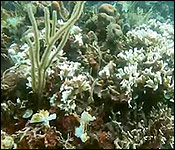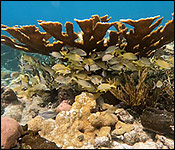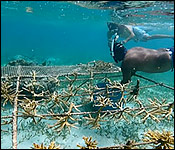

 In environmental news, the Mesoamerican reef is under tremendous stress due to increasingly warm waters - a result of the changing climate - which manifests itself as coral bleaching. But while this problem isn't new, the severity of it has NGOs concerned. That's because this particular event has been continuing for months and the end is not in sight just yet. Today, the founder of Fragments of Hope, who has been caring for Belize's reef for the past decade, spoke to us via Zoom about coral bleaching and what it takes to combat it. Courtney Menzies has this story.
In environmental news, the Mesoamerican reef is under tremendous stress due to increasingly warm waters - a result of the changing climate - which manifests itself as coral bleaching. But while this problem isn't new, the severity of it has NGOs concerned. That's because this particular event has been continuing for months and the end is not in sight just yet. Today, the founder of Fragments of Hope, who has been caring for Belize's reef for the past decade, spoke to us via Zoom about coral bleaching and what it takes to combat it. Courtney Menzies has this story.
Belize's reef is currently undergoing one of the worst bleaching events in decades. Coral bleaching refers to when the water becomes too warm, causing the corals to expel the algae living in their tissues, which turns it white. It's a sign that the coral is under a lot of stress, and according to the founder of Fragments of Hope, it's alarming that this event has continued into January.
Lisa Carne, Founder, Fragments of Hope
"2023, this past year, still ongoing is both in severity and longevity the worse ever. In other words, usually our peak bleaching when things turn white because of the hot water in August, September is around October and then things start to cool off again November, December, you see recovery in previous bad years."
 "This year was unusual because again it started so early in June, then there's almost like we had two major events even though it was one long one because there was a little bit of recovery in August and then October got terrible all over again, by the end of October, November, and the video I shared with you was from January 4th which is unheard of to see that level of whiteness on the reef in January."
"This year was unusual because again it started so early in June, then there's almost like we had two major events even though it was one long one because there was a little bit of recovery in August and then October got terrible all over again, by the end of October, November, and the video I shared with you was from January 4th which is unheard of to see that level of whiteness on the reef in January."
And Carne says that according to experts, it's caused by the super El Nino event that has carried over to 2024, and has been affecting the entire region.
And since there is no cure, over the years, environmental NGOs have had to adapt strategies to make the corals more resilient and resistant.
Lisa Carne, Founder, Fragments of Hope
"So what I mean by our strategy is, we identify the survivors of these terrible bleaching and disease events, who's doing the strongest, then we propagate those and we're moving around into our different out plant site in such a way that because corals are animals they can sexually reproduce as well and so not every stag horn is the same stag horn so we have different individuals of stag horn just like me and you are different female humans and so in order to have successful sexual cross reproduction with corals you have to have different individuals of either the stag horn or the elk horn, the bigger branching one, so that when they do spawn, they have a partner to meet with and make baby corals. So what we say when we talk about that is genetic diversity so we're not having the same individual propagating over and over again because if that same individual is going to bleach then all your coral cover would be lost."
But with this massive bleaching, Fragments of Hope will have to take a break with the out planting so as to not stress the corals even further.
In the meantime, they will be training more Belizean stakeholders to treat coral bleaching. She explained that tour guides and dive masters assist with the restoration, and over the Christmas holiday she received promising news from one of them.
Lisa Carne, Founder, Fragments of Hope
"One of our tour guides, Natasha Gibson, came back I think it was Boxing Day and told me all of the elk horn, the flowered ones at South Caye had recovered and looked amazing and beautiful so we hurried to give her camera because everyday they're going out to these sites with tourism and those are the images I want to share with you for those rays of hope because that was the best news I had gotten."
"Moho Caye again I just finished analyzing that data and the good new from Moho Caye is that of 100% dead, and I'm talking about elk horn, the big one behind me, there's about 490 elk horns, most of them are from us and then a few wild ones at Moho Caye and only about 6% are 100% dead so that's not as horrible as we thought, that's not as horrible as other regional sites where they lost everything in their nurseries and this isn't nurseries, this is out plants on the reef."
But while hope isn't lost, for now, Fragments of Hope will have to wait out this bleaching event before continuing the restoration process - however long that may take.
Major bleaching events also occurred in 1998, 2015 and 2016.



